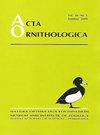蓝山雀在蜗牛数量下降后产下较小的蛋:城市公园蛞蝓控制的间接影响
IF 1.3
4区 生物学
Q3 ORNITHOLOGY
引用次数: 7
摘要
摘要蛋的大小是鸟类一种基本的物种特有的生活史特征,它在雏鸟阶段影响后代的表现,从而影响健康。蜗牛的壳是雌鹦鹉和其他雀形目动物在产卵过程中的主要钙来源。蜗牛壳的短缺可能会导致蛋壳更薄,鸡蛋更小。在需要防止害虫的城市绿地中,蜗牛的数量可能会因杀螺剂的处理而大大减少。2013年和2014年,在波兰Łódź植物园对害虫蛞蝓使用杀软体剂处理,为研究杀软体剂对非目标蜗牛和蓝山雀蓝藻卵的影响提供了独特的准实验环境。我们在一个没有使用任何处理的森林研究地点作为对照区,测试了在植物园中杀螺剂处理对蜗牛密度和蓝山雀卵量的影响。我们发现,在杀螺剂处理后,蜗牛数量急剧下降,这可能限制了植物园蓝山雀产卵的蜗牛壳的可用性。相应地,鸡蛋的大小在花园中显著减少,而在森林中则保持不变。大窝的卵比小窝的卵受杀软体剂的影响更大。我们的准实验研究表明,蓝山雀对蜗牛壳的缺乏很敏感。这表现在产的蛋更小,蛋壳中需要的钙更少,以应对蜗牛壳的急剧减少。这一结果有望提高人们对公园有害生物管理对除软体动物以外的生物群潜在的间接和无意影响的认识。本文章由计算机程序翻译,如有差异,请以英文原文为准。
Blue Tits Cyanistes caeruleus Laying Smaller Eggs after a Decline in Snail Numbers: An Indirect Effect of Slug Control in a City Park
Abstract. Egg size is a basic species-specific life-history trait in birds which influences offspring performance through the nestling stage and, therefore, fitness. Shells of snails are the principal source of calcium for female parids and some other passerines during egg formation. Shortages in the availability of snail shells may lead to laying smaller eggs with thinner shells. In urban green spaces that require protection against pests, the numbers of snails may become greatly reduced in response to molluscicide treatments. The use of a molluscicide treatment against pest slugs in the Botanic Garden, Łódź, Poland, in 2013 and 2014 provided a unique quasi-experimental setting to study the effect of molluscicide on both non-target snails and Blue Tit Cyanistes caeruleus eggs. Using a forest study site where no treatment was applied as a control area, we tested for effects of the molluscicide treatment in the Botanic Garden on the density of snails and on the egg volume of Blue Tits. We found that after the molluscicide treatment a dramatic drop in snail numbers occurred, which likely restricted the availability of snail shells for egg laying Blue Tits in the Botanic Garden. Correspondingly, egg sizes significantly decreased in the Garden, while they stayed constant over time in the forest. Eggs in bigger clutches were more strongly affected by the molluscicide treatment than eggs in smaller clutches. Our quasi-experimental study suggests that Blue Tits are sensitive to poor availability of snail shells. This is manifested by laying smaller eggs, which require less calcium to be incorporated in the eggshell, in response to a dramatic drop in the availability of snail shells. This result is expected to raise awareness of potential indirect and inadvertent effects of park pest management on biota other than molluscan pests.
求助全文
通过发布文献求助,成功后即可免费获取论文全文。
去求助
来源期刊

Acta Ornithologica
生物-鸟类学
CiteScore
2.10
自引率
0.00%
发文量
14
审稿时长
>12 weeks
期刊介绍:
Publishes scientific papers (original research reports, reviews, short notes, etc.) and announcements from all fields of ornithology. All manuscripts are peer-reviewed.
Established in 1933 as Acta Ornithologica Musei Zoologici Polonici, since 1953 continued under the present title.
Published twice a year by the Natura Optima Dux Foundation under the auspices of the Museum and Institute of Zoology, Polish Academy of Sciences.
 求助内容:
求助内容: 应助结果提醒方式:
应助结果提醒方式:


